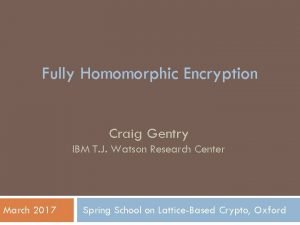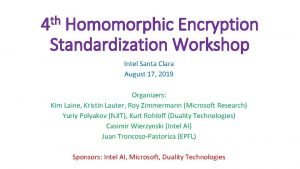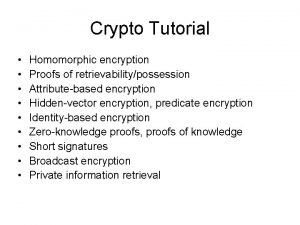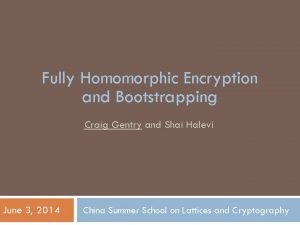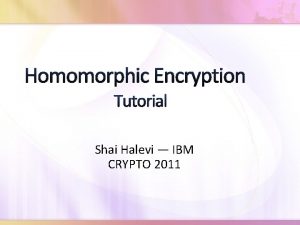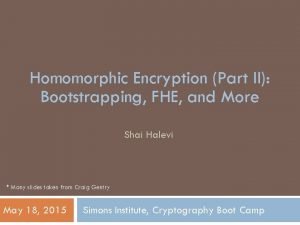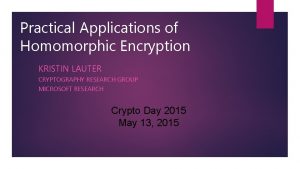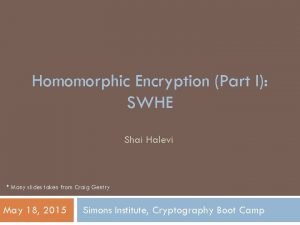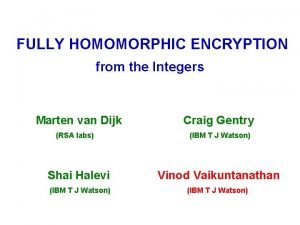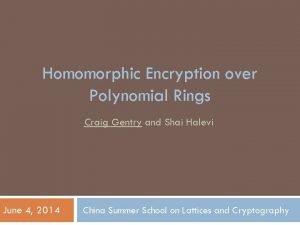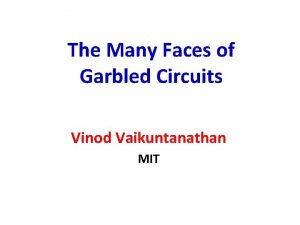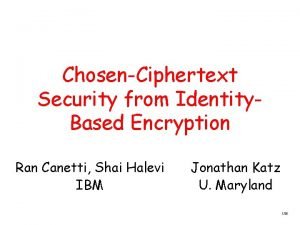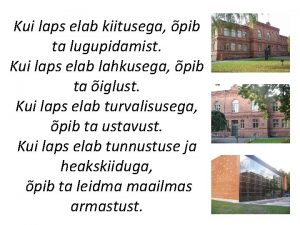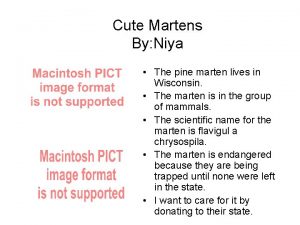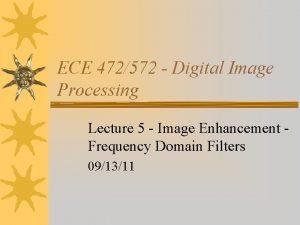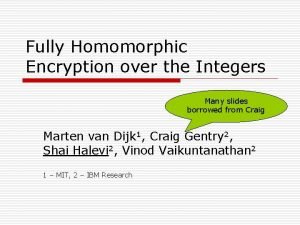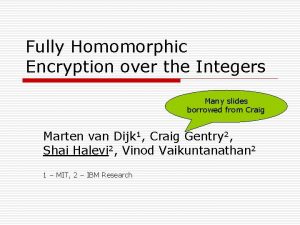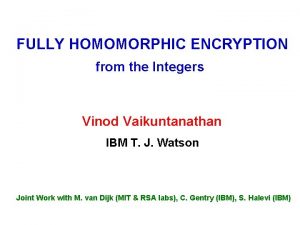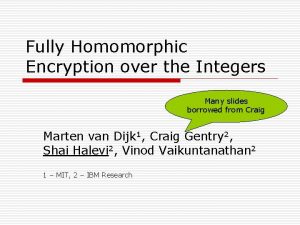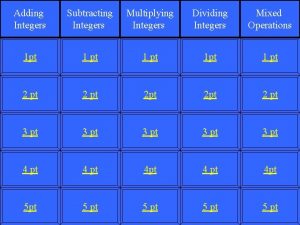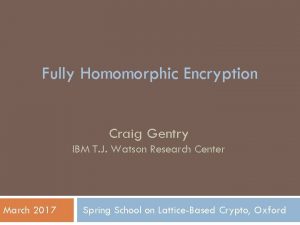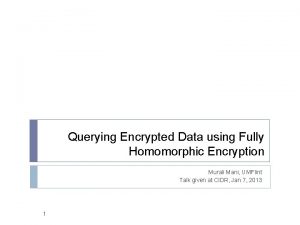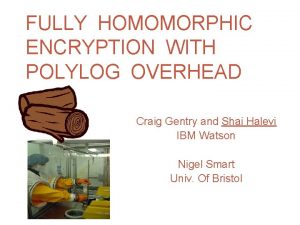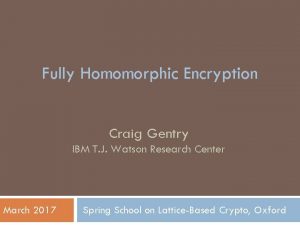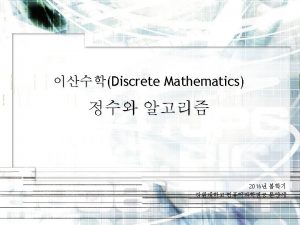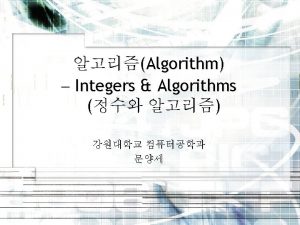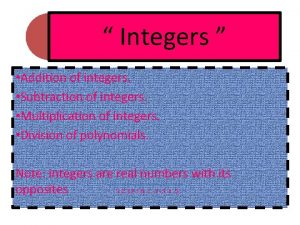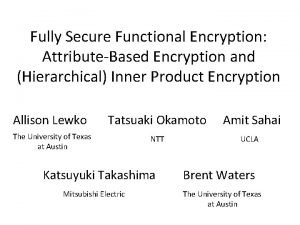FULLY HOMOMORPHIC ENCRYPTION from the Integers Marten van


![= Fully. Homomorphic Encryption (FHE) Eval P Enc(x) Definition: [Key. Gen, Enc, Dec, ]Eval] = Fully. Homomorphic Encryption (FHE) Eval P Enc(x) Definition: [Key. Gen, Enc, Dec, ]Eval]](https://slidetodoc.com/presentation_image_h2/fa1e8e8a4bfd365638a52f0457cc66b6/image-3.jpg)
![Fully Homomorphic Encryption ► First Defined: “Privacy homomorphism” [RAD’ 78] – their motivation : Fully Homomorphic Encryption ► First Defined: “Privacy homomorphism” [RAD’ 78] – their motivation :](https://slidetodoc.com/presentation_image_h2/fa1e8e8a4bfd365638a52f0457cc66b6/image-4.jpg)
![Fully Homomorphic Encryption ► First Defined: “Privacy homomorphism” [RAD’ 78] – their motivation : Fully Homomorphic Encryption ► First Defined: “Privacy homomorphism” [RAD’ 78] – their motivation :](https://slidetodoc.com/presentation_image_h2/fa1e8e8a4bfd365638a52f0457cc66b6/image-5.jpg)
![OUR RESULT Theorem[DGHV’ 10]: We have a fully homomorphic public-key encryption scheme – which OUR RESULT Theorem[DGHV’ 10]: We have a fully homomorphic public-key encryption scheme – which](https://slidetodoc.com/presentation_image_h2/fa1e8e8a4bfd365638a52f0457cc66b6/image-6.jpg)
















![How Hard is Approximate GCD? v Studied by [HG 01]; also [Lag 82, Cop How Hard is Approximate GCD? v Studied by [HG 01]; also [Lag 82, Cop](https://slidetodoc.com/presentation_image_h2/fa1e8e8a4bfd365638a52f0457cc66b6/image-23.jpg)










![From “Somewhat” to “Fully” Theorem [Gentry’ 09]: Convert “bootstrappable” → FHE = Can eval From “Somewhat” to “Fully” Theorem [Gentry’ 09]: Convert “bootstrappable” → FHE = Can eval](https://slidetodoc.com/presentation_image_h2/fa1e8e8a4bfd365638a52f0457cc66b6/image-34.jpg)

- Slides: 35

FULLY HOMOMORPHIC ENCRYPTION from the Integers Marten van Dijk (RSA labs) Craig Gentry (IBM T J Watson) Shai Halevi Vinod Vaikuntanathan (IBM T J Watson)

Computing on Encrypted Data (An Example) “I want to delegate the computation to the cloud, the cloudthe shouldn’t see my “I wantbut to delegate computation toinput” the cloud” Enc(x) P Enc[P(x)] Client (Input: x) Server/Cloud (Program: P)
![Fully Homomorphic Encryption FHE Eval P Encx Definition Key Gen Enc Dec Eval = Fully. Homomorphic Encryption (FHE) Eval P Enc(x) Definition: [Key. Gen, Enc, Dec, ]Eval]](https://slidetodoc.com/presentation_image_h2/fa1e8e8a4bfd365638a52f0457cc66b6/image-3.jpg)
= Fully. Homomorphic Encryption (FHE) Eval P Enc(x) Definition: [Key. Gen, Enc, Dec, ]Eval] (as in regular encryption) Enc[P(x)] Compactness: Size of Eval’ed ciphertext independent of P Security: Semantic Security [GM’ 82]
![Fully Homomorphic Encryption First Defined Privacy homomorphism RAD 78 their motivation Fully Homomorphic Encryption ► First Defined: “Privacy homomorphism” [RAD’ 78] – their motivation :](https://slidetodoc.com/presentation_image_h2/fa1e8e8a4bfd365638a52f0457cc66b6/image-4.jpg)
Fully Homomorphic Encryption ► First Defined: “Privacy homomorphism” [RAD’ 78] – their motivation : searching encrypted data ► Limited Variants: – RSA & El Gamal: multiplicatively homomorphic – GM & Paillier: additively homomorphic – BGN’ 05 & GHV’ 10 a: quadratic formulas ► NON-COMPACThomomorphic encryption [CCKM 00, SYY 99, IP 07, MGH 08, GHV 10 b, …]
![Fully Homomorphic Encryption First Defined Privacy homomorphism RAD 78 their motivation Fully Homomorphic Encryption ► First Defined: “Privacy homomorphism” [RAD’ 78] – their motivation :](https://slidetodoc.com/presentation_image_h2/fa1e8e8a4bfd365638a52f0457cc66b6/image-5.jpg)
Fully Homomorphic Encryption ► First Defined: “Privacy homomorphism” [RAD’ 78] – their motivation : searching encrypted data Big Breakthrough : [Gentry 09] First Construction of Fully Homomorphic Encryption using algebraic number theory / “ideal lattices” No ideal lattices ► Is there an elementary. Construction of FHE? – using just integer addition and multiplication – easier to understand, implement and improve
![OUR RESULT TheoremDGHV 10 We have a fully homomorphic publickey encryption scheme which OUR RESULT Theorem[DGHV’ 10]: We have a fully homomorphic public-key encryption scheme – which](https://slidetodoc.com/presentation_image_h2/fa1e8e8a4bfd365638a52f0457cc66b6/image-6.jpg)
OUR RESULT Theorem[DGHV’ 10]: We have a fully homomorphic public-key encryption scheme – which uses only add and mult over the integers, – which is secure based on the approximate GCD problem & the sparse subset sum problem.

Construction

A Roadmap 1. Secret-key “Somewhat” Homomorphic Encryption (under the approximate GCD assumption) (a simple transformation) 2. Public-key “Somewhat” Homomorphic Encryption (under the approximate GCD assumption) (borrows from Gentry’s techniques) 3. Public-key FULLY Homomorphic Encryption (under approx GCD + sparse subset sum)

Secret-key Homomorphic Encryption Secret key: an n 2 -bit odd number p (sec. param = n) To Encrypt a bit b: – pick a random “large” multiple of p, say q·p (q ~ n 5 bits) (r ~ n bits) – pick a random “small” even number 2·r – Ciphertext c = q·p+2·r+b “noise” To Decrypt a ciphertext c: – c (mod p) = 2·r+b – read off the least significant bit

Secret-key Homomorphic Encryption How to Add and Multiply Encrypted Bits: – Add/Mult two near-multiples of p gives a near-multiple of p – c 1 = q 1·p + (2·r 1 + b 1), c 2 = q 2·p + (2·r 2 + b 2) – c 1+c 2 = p·(q 1 + q 2) + 2·(r 1+r 2) + (b 1+b 2) «p LSB = b 1 XOR b 2 – c 1 c 2 = p·(c 2·q 1+c 1·q 2 -q 1·q 2) + 2·(r 1 r 2+r 1 b 2+r 2 b 1) + b 1 b 2 « p LSB = b 1 AND b 2

Two Issues Ciphertext grows with each operation → Useless for many applications (cloud computing, searching encrypted e-mail) Noise grows with each operation – Consider c = qp+2 r+b ← Enc(b) – c (mod p) = r’ ≠ 2 r+b (q-1)p qp r’ (q+1)p (q+2)p

Two Issues Ciphertext grows with each operation → Useless for many applications (cloud computing, searching encrypted e-mail) Noise grows with each operation → After some operations, the ciphertext becomes “undecryptable”

Solving the Two Issues Ciphertext grows with each operation – Publish x 0 = q 0 p (*) – Take ciphertext (mod x 0) after each op (Add/Mult) (*) More complex way using x 0 = a near-multiple of p

Solving the Two Issues Ciphertext grows with each operation – Publish x 0 = q 0 p – Take ciphertext (mod x 0) after each op (Add/Mult) v Ciphertext stays less than x 0 always v The encrypted bit remains same v Noise does not increase at all

Solving the Two Issues Ciphertext grows with each operation – Publish x 0 = q 0 p – Take ciphertext (mod x 0) after each op (Add/Mult)* Noise grows with each operation v Can perform “limited” number of hom. operations (“Somewhat Homomorphic” Encryption) – Somewhat → Fully: (A variant of) Squashing + Bootstrapping [G’ 09]

Security (of the secret-key “somewhat” homomorphic scheme)

The Approximate GCD Assumption (name coined by Howgrave-Graham) Parameters of the Problem: Three numbers P, Q and R p? (q 0 p, q 1 q p+r , …, q p+rt) q 1 p+r 01 p 1 t p qq 0 ← ← [0…Q] Assumption: no PPT adversary can guess the number p r ← [-R…R] odd p ← [0…P]

(q 0 p, q 1 p+r 1, …, qtp+rt) p? p Assumption: no PPT adversary can guess the number p = (proof of security) Semantic Security: no PPT adversary can guess the bit b (q 0 p, q 1 p+2 r 1+b, …, qkp+2 rk+b)

A “Taste” of the Security Proof Encryption breaker p q 0 p, {qip+ri} Approx GCD solver p q 0 p, {qip+ri} c=qp+r Adv lsb(q) A q B Claim: On every c=qp+r, A predicts lsb(q) correctly w. p. 1 -1/poly “Proof”: Lots of details (Worst-case to average case over c, computing lsb(q) = computing lsb(r), a hybrid argument. )

A “Taste” of the Security Proof p q 0 p, {qip+ri} p c=qp+r Adv lsb(q) A q 0 p, {qip+ri} c=qp+r q Adv B Main Idea: Use lsb(q) to make q successively smaller First Try: – If lsb(q) = 0, c ← [c/2] – If lsb(q) = 1, c ← [(c-p)/2] (new-c = q/2*p+[r/2]) (new-c = (q-1)/2*p+[r/2])

A “Taste” of the Security Proof Main Idea: Use lsb(q) to make q successively smaller Lemma: Given two near-multiples z 1=q 1 p+r 1 and z 2=q 2 p+r 2 (+lsb oracle), can compute z’=gcd(q 1, q 2)·p+r’ for small r’ W. h. p. gcd(q 1, q 2)=1 – If lsb(q) = 0, c ← [c/2] – If lsb(q) = 1, c ← [(c-z’)/2] [(c-p)/2] – Learn q bit by bit (new-c = q/2*p+[r/2]) (new-c = (q-1)/2*p+[(r-r’)/2] (q-1)/2*p+[r/2]) )

A “Taste” of the Security Proof Main Idea: Use lsb(q) to make q successively smaller Lemma: Given two near-multiples z 1=q 1 p+r 1 and z 2=q 2 p+r 2 (+lsb oracle), can compute z’=gcd(q 1, q 2)·p+r’ for small r’ Observation: the Binary GCD algo. is “noise-tolerant”, given lsb oracle. (similar to the RSA hardcore bit proof of [ACGS’ 88])
![How Hard is Approximate GCD v Studied by HG 01 also Lag 82 Cop How Hard is Approximate GCD? v Studied by [HG 01]; also [Lag 82, Cop](https://slidetodoc.com/presentation_image_h2/fa1e8e8a4bfd365638a52f0457cc66b6/image-23.jpg)
How Hard is Approximate GCD? v Studied by [HG 01]; also [Lag 82, Cop 97, NS 01] (equivalent to “simultaneous Diophantine approximation”) v Lattice-based Attacks – Lagarias’ algorithm – Coppersmith’s algo. for finding small polynomial roots – Nguyen/Stern and Regev’s orthogonal lattice method v All run out of steam when log Q > (log P)2 (our setting of parameters: log Q = n 5, log P = n 2)

Future Directions Efficient fully homomorphic encryption (Currently: n 5 size ciphertexts; n 10 running-time blowup) Some recent improvements [SV’ 10, SS’ 10] Security of the approx GCD assumption (e. g. , a worst-case to average-case reduction to regular – non-ideal – lattice problems? )

Questions?

Public-key Homomorphic Encryption Secret key: an n 2 -bit odd number p Δ Public key: [q 0 p+2 r 0, q 1 p+2 r 1, …, qtp+2 rt] = (x 0, x 1, …, xt) = t+1 random encryptions of 0 To Decrypt a ciphertext c: – c (mod p) = 2·r+b – read off the least significant bit Eval (as before)

Public-key Homomorphic Encryption Secret key: an n 2 -bit odd number p Δ Public key: [q 0 p+2 r 0, q 1 p+2 r 1, …, qtp+2 rt] = (x 0, x 1, …, xt) To Encrypt a bit b: pick random subset S c= + b (mod x 0) To Decrypt a ciphertext c: – c (mod p) = 2·r+b – read off the least significant bit Eval (as before) [1…t]

Parameter Regimes log Q/(log P)2 (very rough diagram) min=0 max=P R

Public-key Homomorphic Encryption Secret key: an n 2 -bit odd number p Δ Public key: [q 0 p+2 r 0, q 1 p+2 r 1, …, qtp+2 rt] = (x 0, x 1, …, xt) – t+1 encryptions of 0 – W. l. o. g. , x 0 = q 0 p+2 r 0 is the largest To Decrypt a ciphertext c: – c (mod p) = 2·r+b – read off the least significant bit Eval (as before)

Public-key Homomorphic Encryption Secret key: an n 2 -bit odd number p Δ Public key: [q 0 p+2 r 0, q 1 p+2 r 1, …, qtp+2 rt] = (x 0, x 1, …, xt) To Encrypt a bit b: pick random subset S c= [1…t] + b (mod x 0) To Decrypt a ciphertext c: (mod x 0) a small k) = p[p) = 2·r+b ] + 2[ +b– kx 0 (for – c c(mod p) =] 2·r+b – read= off p[ the least significant ] + 2[ bit ]+b of p) + (“small” even noise) + b Eval (as (mult. before)

Public-key Ciphertext Homomorphic Size Reduction Encryption Secret key: an n 2 -bit odd number p Δ Public key: [q 0 p+2 r 0, q 1 p+2 r 1, …, qtp+2 rt] = (x 0, x 1, …, xt) To Encrypt a bit b: pick random subset S [1…t] – Resulting ciphertext < x 0 c= + b (mod x 0) – Underlying bit is the same (since x 0 has even noise) –To. Noise Decrypt ciphertext c: by much(*) doesa not increase – c (mod p) = 2·r+b – read off the least significant bit Eval: Reduce mod x 0 after each operation (*) additional tricks for mult

A Roadmap þ Secret-key “Somewhat” Homomorphic Encryption þ Public-key “Somewhat” Homomorphic Encryption 3. Public-key FULLY Homomorphic Encryption

How “Somewhat” Homomorphic is this? Can evaluate (multi-variate) polynomials with m terms, and maximum degree d if: or f(x 1, …, xt) = x 1·x 2·xd + … + xt-d+1·xt-d+2·xt Say, noise in Enc(xi) < 2 n Final Noise ~ (2 n)d+…+(2 n)d = m • (2 n)d
![From Somewhat to Fully Theorem Gentry 09 Convert bootstrappable FHE Can eval From “Somewhat” to “Fully” Theorem [Gentry’ 09]: Convert “bootstrappable” → FHE = Can eval](https://slidetodoc.com/presentation_image_h2/fa1e8e8a4bfd365638a52f0457cc66b6/image-34.jpg)
From “Somewhat” to “Fully” Theorem [Gentry’ 09]: Convert “bootstrappable” → FHE = Can eval all fns. Augmented Decryption ckt. “Somewhat” HE “Bootstrappable” NAND Dec c 1 sk Dec c 2 sk

Is our Scheme “Bootstrappable”? What functions can the scheme EVAL? (polynomials of degree < n) (? ) Complexity of the (aug. ) Decryption Circuit (degree ~ n 1. 73 polynomial) Can be made bootstrappable – Similar to Gentry’ 09 Caveat: Assume Hardness of “Sparse Subset Sum”
 Why ibm fully encryption
Why ibm fully encryption Homomorphic encryption standard
Homomorphic encryption standard Homomorphic encryption tutorial
Homomorphic encryption tutorial Homomorphic encryption tutorial
Homomorphic encryption tutorial Craig gentry homomorphic encryption
Craig gentry homomorphic encryption Homomorphic encryption tutorial
Homomorphic encryption tutorial Gsw homomorphic encryption
Gsw homomorphic encryption Shai halevi
Shai halevi Practical homomorphic encryption
Practical homomorphic encryption Swhe
Swhe Homomorphic encryption
Homomorphic encryption Craig gentry homomorphic encryption
Craig gentry homomorphic encryption What are these
What are these Skw vk
Skw vk Mårten sjödell
Mårten sjödell Reet meetua
Reet meetua Pandas
Pandas Pine marten vermont
Pine marten vermont Mårten rignell
Mårten rignell Peter marten
Peter marten Cute pine marten
Cute pine marten Homomorphic filtering block diagram
Homomorphic filtering block diagram Hình ảnh bộ gõ cơ thể búng tay
Hình ảnh bộ gõ cơ thể búng tay Slidetodoc
Slidetodoc Bổ thể
Bổ thể Tỉ lệ cơ thể trẻ em
Tỉ lệ cơ thể trẻ em Gấu đi như thế nào
Gấu đi như thế nào Tư thế worms-breton
Tư thế worms-breton Alleluia hat len nguoi oi
Alleluia hat len nguoi oi Môn thể thao bắt đầu bằng chữ f
Môn thể thao bắt đầu bằng chữ f Thế nào là hệ số cao nhất
Thế nào là hệ số cao nhất Các châu lục và đại dương trên thế giới
Các châu lục và đại dương trên thế giới Công thức tính độ biến thiên đông lượng
Công thức tính độ biến thiên đông lượng Trời xanh đây là của chúng ta thể thơ
Trời xanh đây là của chúng ta thể thơ Mật thư anh em như thể tay chân
Mật thư anh em như thể tay chân Làm thế nào để 102-1=99
Làm thế nào để 102-1=99
